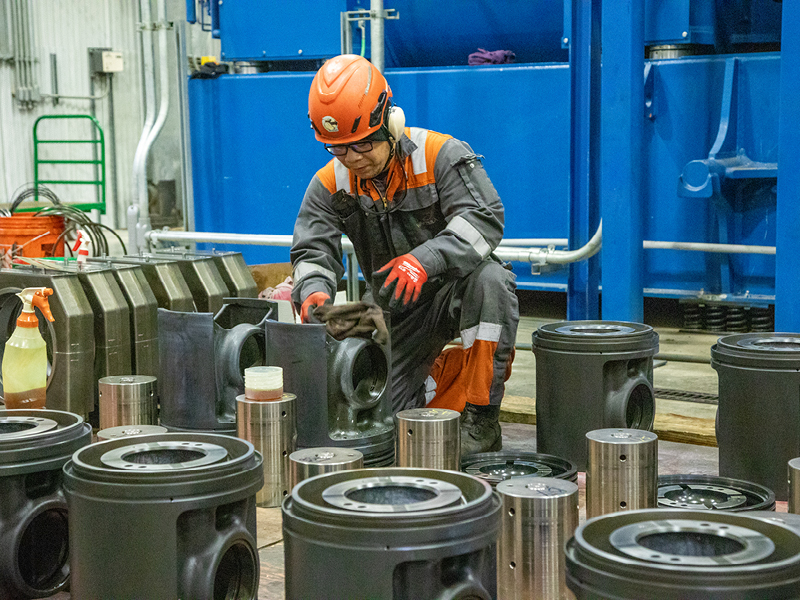Basin Electric is a safe, environmentally responsible cooperative that provides reliable, affordable power, products, and services to sustain the quality of life for our member-owners across rural America.
This mission, newly refreshed in 2023, unifies the Basin Electric team in a common purpose, helping everyone use the same map to get where the cooperative needs to go. However, the mission is neither simple nor easy. Both the members and employees of the cooperative demonstrate resilience in serving this mission while Basin Electric is facing unparalleled load growth amongst its peers in the United States — a projected 3.2% growth annually over the next 10 years; national average growth over the same time period is approximately 0.7%.
Basin Electric generates and delivers electricity to 141 member cooperatives across nine states, serving a large geographical footprint through the middle of the United States. Areas of rural America across the Upper Great Plains are attractive to industries, companies, and people due to the availability of land and resources, along with reliable and affordable electricity.
Thanks to these attractive qualities, the growth occurring and forecasted to occur within Basin Electric’s service area is in the residential and commercial sectors as well as cryptocurrency and data processing loads, the projected emergence of ethanol production-related carbon dioxide (CO2) capture and sequestration, and continued economic development in western North Dakota.
Basin Electric’s next five to 10 years will be focused on investment. Strategically investing in critical resources will shape the cooperative’s future, ensuring our members are served with reliable and affordable electricity produced in a safe and environmentally responsible manner.
The cooperative will invest in reliability through additional generation and transmission facilities, and upgrades to our current facilities. The cooperative team will focus on solutions that keep reliable, affordable, and safe electricity in the forefront. Basin Electric will invest in its members by continuing to provide electricity and products that enrich their lives and strengthen their communities. And the cooperative will invest in its employees through a focus on safety, organizational development, and strategic modernization.

Addressing Volatility
Basin Electric’s member load forecast, the tool used to determine how much electricity is needed for the next decade and beyond, is used for multiple purposes, from power supply and transmission planning to financial forecasting and rate planning. The bandwidth forecast captures a range of possible outcomes, with the actuals likely falling somewhere in between, an approach especially useful when forecasting loads or sectors with high unpredictability.
While a bandwidth approach for the load forecast has become especially prudent, an updated approach to some rates was necessary to help protect continued affordability for all members.
The types of loads entering Basin Electric’s membership are quickly changing. While the categories of residential, agricultural, and industrial once encompassed most loads, Basin Electric members are now receiving inquiries from companies wanting to build data centers, some of which would be used for cryptocurrency mining, that could each use anywhere from a few megawatts (MW) to 100-200 MW of electricity; compare that to an ethanol plant, common across Basin Electric’s membership area, which on average is 7 MW. These loads prefer the cooler temperatures of the Upper Great Plains, which help the constantly running servers stay cool.
Not only are the loads large, but they are unpredictable in nature — because electricity is the major variable cost of crypto mining and the process consumes so much electricity, companies building the data centers want the lowest cost power they can find, choosing “interruptible power” where they turn off the processors or servers when the price gets to a point where mining isn’t cost effective.
To mitigate risk, new rates were designed for these loads. The proposed new crypto and large load rates have a market-based pass-through structure whereby Basin Electric is incurring market charges and then passing them through to the member along with an administrative charge. These new rates would provide members with a rate structure to offer these loads while minimizing the risk of negatively impacting the rest of the membership. The new rates are planned to go into effect in June 2024, pending Federal Energy Regulatory Commission (FERC) approval. Based on conversations with Basin Electric’s FERC legal counsel, this will be the first time FERC will contemplate rates specific to crypto-related loads.

Investing in Reliable Electricity
The way our nation is using electricity is evolving, and as more industries and devices are turning to electricity, people’s lives and livelihoods depend on electricity more than ever.
We tend to associate power outages, or lack of reliability, with downed power lines. While this is most often the case, the nation’s changing generation mix is more frequently impacting reliability. Dispatchable generation resources are able to be turned on, or dispatched, as needed, while non-dispatchable generation resources are not. In the United States, the generation mix is shifting from dispatchable resources like nuclear, coal, and natural gas generation to non-dispatchable, renewable resources. The generation mix has changed considerably over the last decade in SPP (Southwest Power Pool) and MISO (Midcontinent Independent System Operator), two regional transmission organizations (RTO) Basin Electric participates in. The pending generation interconnection requests in SPP and MISO indicate that these trends are likely to continue.
Unfortunately, non-dispatchable resources can be impacted in unique ways. During severe cold, wind turbines need to shut down to protect equipment. Precipitation during colder weather can create icing on turbine blades. Snow can cover solar panels. And any time of year, no matter the temperature, the wind may not blow and the sun may not shine when electricity is needed most — when loads are highest due to cold or hot weather events.
Even as it becomes the dominant dispatchable resource, natural gas generation is not without its challenges, given the fuel must be continually transported via pipeline as opposed to inventoried on site like nuclear and coal fuel sources.
In short, the shift away from dispatchable generation with on-site fuel storage to more non-dispatchable generation means the U.S. electrical system is becoming less resilient and more fragile.
Basin Electric is committed to reliability as demonstrated by the cooperative’s capital expenditure program. There are several major projects building or strengthening generation and transmission infrastructure underway with a forecasted cost of $2 billion. Over the next five years, Basin Electric’s financial forecast projects $4 billion in capital expenditures.
Evolving Transmission Markets
The benefits of participation in an RTO are many: organizations such as SPP and MISO allow for the sharing of generation and transmission resources and determine the most economic and reliable way for all the available resources and transmission to serve the load.
Alongside these benefits, however, Basin Electric’s efforts can be constrained in several ways despite having resources to ensure reliability. Inside of the RTOs’ operations, during energy emergency events, if there is not enough generation in the market to serve all of the market load, the RTOs and Transmission Operators have the ability to direct Basin Electric and other market participants to shed load, or cut power to customers. This is performed regardless of Basin Electric’s own resource availability.
When the RTOs declare Conservative Operations, meaning the event is not an emergency but conditions are such that they must operate more conservatively, RTOs will sometimes limit or cancel maintenance outages at generation facilities, and operate with an increased operating reserve level, for example.
While evolving conditions have led to strains on both reliability and affordability, utilities and RTOs are finding new ways to create efficiencies within the system. Basin Electric is one of seven western utilities to sign a Commitment Agreement with SPP in September 2023 to continue the process of exploring membership in a West-side RTO.
SPP expects the expansion of its service territory to create economic and reliability benefits for its market participants through access to a larger generation fleet, integrated transmission system, greater geographic diversity, and efficiencies with the current SPP RTO.
As Basin Electric determines whether to eventually join the RTO in the West, several uncertainties need to be balanced. Environmental regulations, renewable growth in the West, and potential transmission buildouts need to be considered. Basin Electric has until early 2026 to make a final decision about joining this new SPP West RTO.
Managing Regulatory Overreach
While the way members use electricity is changing, and utilities and markets are developing solutions, there is a factor pressing in on dispatchable generation units that continues to make operation difficult or costly.
Proposed federal regulations are threatening Basin Electric and other electric cooperatives’ ability to provide reliable and affordable electricity to their members. The Environmental Protection Agency recently proposed greenhouse gas emissions rules that pose the biggest risk to reliability. The proposed regulation would force utilities into a decision to either install costly and unproven technology on an unrealistic timeline that relies on infrastructure that does not exist, or commit to prematurely retire power generation facilities.
Basin Electric is working with trade organizations, transmission organizations, other utilities, and state and local governments to educate and encourage the development of a balanced and reasonable final rule that doesn’t jeopardize reliability and affordability.



